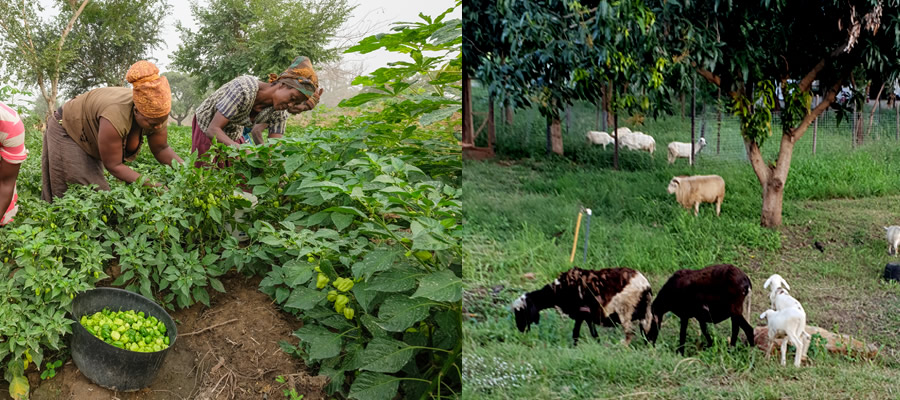

The agriculture sector has not seen growth within the past few years in spite of several government initiatives aimed at facilitating the growth of the sector. This has basically been caused by the loss of existing farmlands to sand winners as well as growth in estate development and acquisition of land for private housing projects. It has been observed that incomes accrued from lease of lands to private and estate developers are generally higher than for agricultural purposes hence, the preference of landowners to lease out lands for purposes other than agriculture.
The land issue not withstanding, the Ga West Municipal lies in the catchment area of the President’s Special Initiative for cassava for the production of industrial starch. The Roots and Tuber Improvement programme which has tremendous government support and funding as well as the Export Development and Investment Fund, that can be accessed by pineapple producers and exporters alike, provide good opportunities for local farmers.
The tremendous market opportunities for these agricultural products present a big challenge to the Assembly to focus on creating the enabling environment as well as supporting agriculture-based enterprises to create jobs for the unemployed and reduce poverty among the people.
The poultry and livestock sub sector have in recent times experienced a decreased growth rate. With respect to poultry production, high cost of inputs such as day old chicks, feed, drugs etc has resulted in high production cost. The importation of selectively cheaper poultry products especially from Europe has further aggravated the situation. Farmers would require the support of government to considerably reduce the cost of production to enable them compete favourably on the market.
The fisheries sub sector has also not seen any significant growth in spite of the fact that communities along the coastline depend on fishing and fish processing as their main source of income and livelihood. This is mostly due to the over exploitation of this resource through unapproved fishing methods. Also, fishing activities carried out in the lakes and rivers have been on small-scale basis.
There is therefore the need to increase investments in this sector especially in the area of fish farming to improve growth in the sector through maximising the use of the existing water sources.
Agricultural Production and Services
Agriculture supports about 55 percent of the economically active population in the Municipality directly or indirectly through farming, livestock development, fisheries, and distribution of farm produce and provision of services to the sector. About 95% of the farmers are small holders with 5% being large-scale holders. Approximately 70% of those in the rural areas depend on agriculture and agricultural related activities for their livelihood. Commercial holdings are mainly into non-traditional export crops such as pineapple, chilli peppers, pawpaw and some Asian vegetables such as tinda and marrow.
Productivity in the municipality is rather low due several factors. These include high illiteracy rate, poor soil conservation and improvement management skills, low capital, and high cost of inputs. High incidence of pests and diseases, high post losses (25-30%), the persistent use of traditional farming methods and over dependence of rain-fed agriculture. Rainfall is insufficient and erratic and irrigation infrastructure is almost non-existent due to high cost.
Land Tenure System
Land as a factor for agricultural production is under siege from the estate development sector either for physical structures or for sand winning or stone quarrying. Land sizes for production are small and over exploited without any meaningful soil conservation and improvement practices.
Chiefs are the custodians of land and hold them in trust for their subjects. However, direct ownership is in the hands of clan or family heads. Anyone in the lineage could inherit from the grandparent/parents. Land could be owned either by direct purchase of leas share cropping tenure arrangement for a period of one farming season is also common operation of land. Land sale is one of the quickest ways of making money and the major cause of conflict is land ownership.
Marketing and Market Facilities
Even though there are ready markets available for farm produce, crop farmers, especially do not control the pricing of their goods. The highly perishable nature of most agricultural produce couple with the glut at immediate harvest times account for the low prices of produce, leading to low prices.
Lack of information on prevailing market prices and the inability of farmers to freely enter established markets due to the presence of powerful market queens continue to permit the exploitation of farmers by market women and middle men.
Post Harvest
Significant post harvest losses particularly cassava; cowpea, maize and vegetables are recorded. The average annual post harvest loss for maize is estimated to be between 20 to 25%. The loss is even higher in cowpea, vegetables and cassava. Aside of a few traditional silos, warehouse with drying facilities are virtually absent.
Date Created : 11/20/2017 7:11:00 AM










 facebook
facebook
 twitter
twitter
 Youtube
Youtube
 +233 593 831 280
+233 593 831 280 0800 430 430
0800 430 430 GPS: GE-231-4383
GPS: GE-231-4383 info@ghanadistricts.com
info@ghanadistricts.com Box GP1044, Accra, Ghana
Box GP1044, Accra, Ghana